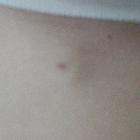Polythelie




Supernumerary nipples are a common minor congenital malformation that consists of accessory nipples.
Supernumerary nipples are located along the embryonic milk lines. Ectopic supernumerary nipples are found beyond the embryonic milk lines. In human beings, the embryonic milk line extends from a point beyond the axillae on the arms, down the chest and the abdomen towards the groin, and is generally thought to end at the proximal inner sides of the thighs.When these nipples appear with complete with breast tissue and ducts, they are referred to as polymastia.
Clinical presentation
May remain undetected. Occasionally, the supernumerary nipple is noticed when hormonal changes during adolescence, menstruation, or pregnancy cause increased pigmentation, fluctuating swelling, tenderness, or even lactation.
Pathology
Between the fourth and fifth weeks of embryogenesis, an ectodermal thickening forms symmetrically along the ventral lateral sides of the embryo. This epidermal ridge extends from the axillary region to the inner side of the thigh to form the embryogenic milk (or mammary) line. During the second and third embryogenic months, the glandular elements of the breasts are formed near the fourth and fifth ribs, with regression of the rest of the thickened ectodermal streaks. In the case of failure of a complete regression, some foci may remain to result in a supernumerary nipple. This can develop into a supernumerary complete breast (polymastia).
Associations
It is said to be found in association with many syndromes and other conditions
Syndromes
- Turner syndrome
- Fanconi anemia
- ectodermal dysplasia
- Kaufman-McKusick syndrome
- Char syndrome
- Simpson-Golabi-Behmel syndrome
- epibulbar lipodermoids associated with preauricular appendages syndrome
Central nervous system
- epilepsy
- migraine
- neurosis
- familial alcoholism
- fetal alcohol syndrome
- intracranial aneurysm
- neural tube defect
- developmental delay
Gastrointestinal
Ear, nose, throat and lung
- laryngeal web
- ear abnormalities
- accessory lung lobe
Skeletal
- hand malformation
- vertebral anomaly
- absent rib
- coronal suture synostosis
- hemihypertrophy
- arthrogryposis
- microcephaly
Cardiac
- conduction defect
- bundle branch block
- patent ductus arteriosus
- congenital heart disease
Treatment and prognosis
Most often no treatment is required; however, a protruding embarrassing supernumerary nipple can be removed surgically, if desired. Removal using liquid nitrogen cryotherapy has also been described.
Siehe auch:

 Assoziationen und Differentialdiagnosen zu Polythelie:
Assoziationen und Differentialdiagnosen zu Polythelie: